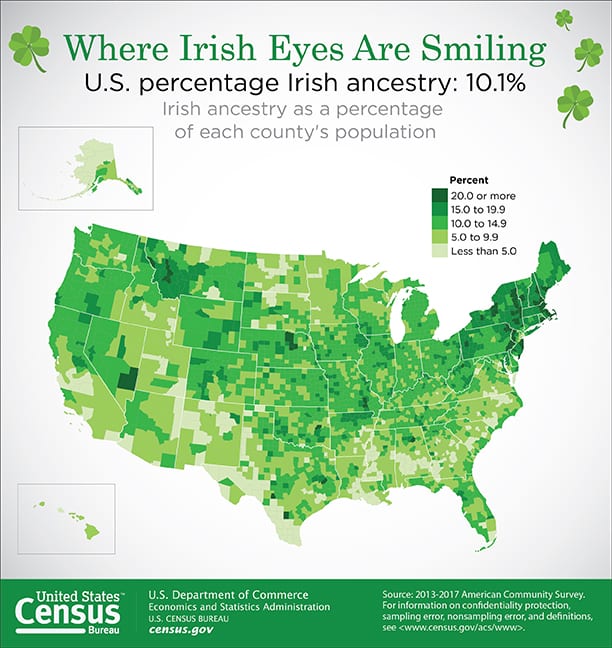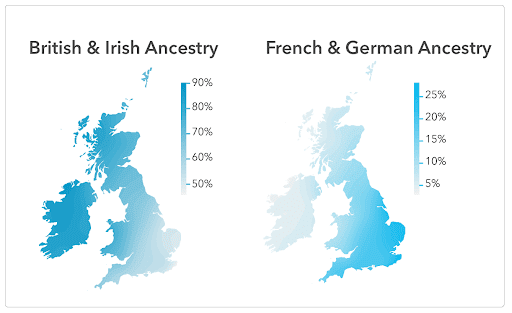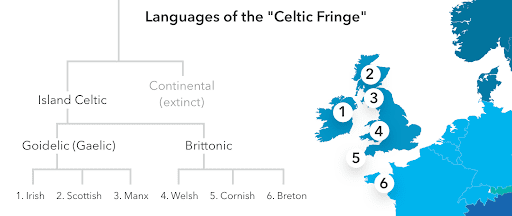Millions of 23andMe customers in the United States have some Irish ancestry, and because March is Irish-American Heritage Month, we’re again sharing something we looked at not too long ago about where in Ireland their ancestors called home.
We learned that although Irish immigration peaked in the U.S. in the mid-19th century, many of the connections we found were much more recent. To more closely examine those connections, we looked at how many customers in the United States reported having Irish grandparents. Then we asked those customers where in Ireland their grandparents called home.
Where in Ireland
Most reported connections to the counties of Cork, Mayo, or Galway in The Republic of Ireland. Others also had grandparents from the cities of Belfast and Dublin. Belfast is the largest city in Northern Ireland, while Dublin is the biggest in the Republic of Ireland.
The darker the shading on the map below, the more customers who report grandparents from that region.

Coming to America
As a result of the Irish potato famine between 1845–1849, Ireland experienced a sustained exodus of people — and to date, the island’s population has not recovered to pre-famine numbers.
Many of those immigrants wound up in the United States, but what is interesting is that our data showed patterns of recent Irish ancestry that mimicked historical patterns of migration to the United States.
So 23andMe researchers dug a little deeper. We did this by looking at data from customers with grandparents from Ireland. Sure enough, we saw higher concentrations of people with recent Irish ancestry in the Northeast, particularly New York, Massachusetts, and Connecticut. Mapping that data we saw more clearly where in the United States many of these immigrants wound up. (See Census map from 2019 below that aligns with our own look at the distribution of where people with Irish ancestry live.)

The data also showed fewer individuals with recent Irish ancestry in the Deep South and the Southwest. It’s important to note that this is not mapping genetic ancestry. Rather it is looking at concentrations of where people who reported having grandparents that were born in Ireland currently live.
While this data was not the most surprising to our population geneticists, what’s interesting is that the state-wide segmentation mirrors U.S. Census data on reported Irish ancestry. It also aligns with long-established patterns of where Irish immigrants have settled since first arriving in the country. Certain communities, like Plymouth County south of Boston Massachusetts, have higher concentrations of people with Irish ancestry in the country, according to the U.S. Census Bureau
Studies of Irish Ancestry reveal unexpected connections
In a number of recent studies (7, 8, 9), researchers identified distinct genetic clusters within the island of Ireland. While Irish people tended to be genetically similar to each other, there were a few regional differences the study was able to identify within the DNA.
For example, southern Ireland was the most genetically distinct from the rest of the island, followed by Northern Ireland and central Ireland (which split rather unexpectedly into a northern half and a southern half).
Why unexpected?
Historically, there were four traditional Irish provinces: Ulster in the North, Munster in the South, Connacht in the West, and Leinster in the East. According to the DNA, It seems that people migrated between East and West in Central Ireland over time, obscuring some of these traditional borders.

Why “British & Irish” ancestry peaks in Ireland
Our own researchers were able to explore the impact of ancient and historical migration from mainland Europe into the British Isles (1, 2, 3, 4, 5, 6). There are clear geographic differences in our customers’ average ancestry percentages. Customers with four grandparents born in Ireland tend to have more British & Irish ancestry than customers with four grandparents born in Great Britain.
You can clearly see that French & German ancestry reaches over 25% in England’s Southeast, where British & Irish ancestry hovers around 50%. Compare that to more than 90% British and Irish ancestry in western Ireland, or more than 75% in western Wales and northern Scotland.

What’s the “Celt Belt” and where did Celtic languages come from?
Celtic languages and culture first appeared in Central Europe, extending from the British Isles to the Black sea by the 3rd century BCE. But, the rise of the Roman Empire spelled the downfall of a Celtic-speaking Europe.

Today, while Celtic languages can only be found along the “Celtic Fringe” or the “Celt Belt” along the far western periphery of their former territory, Celtic cultural heritage remains deeply meaningful to millions of people around the world.

Genetic Origins of the “Celtic Curse”
Bagpipes, intricate metalwork and red hair are often associated with Celtic heritage, but less familiar is the link between “Celtic-like” ancestry and hereditary hemochromatosis. Hemochromatosis is a condition characterized by the absorption of too much dietary iron, which can cause damage to the joints and certain organs.
Today, the DNA variants associated with this condition are common in Ireland, leading to the nickname, “The Celtic Curse,” as it’s commonly known in the scientific and hemochromatosis communities. However, most evidence points to a central European origin of the most common variant (HFE C282Y), which was likely carried to the British Isles thousands of years ago and further spread by medieval Viking migrations. Some scientists have proposed that the C282Y variant may have protected our farming ancestors from iron-deficient diets, but the evidence for this “protective” role is limited.

If you’re a Health + Ancestry customer, your Hereditary Hemochromatosis (HFE-related) report is available here.